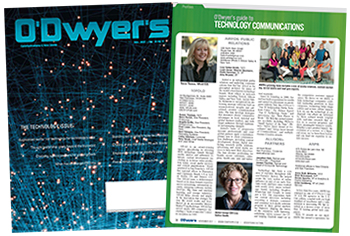|
|
“We are stuck with technology when what we really want is just stuff that works.”
— Douglas Adams
As brands fight for attention across media and devices, connecting with an audience while remaining authentic has never been more challenging — or vital — to success. Brands frequently respond to this challenge by layering the latest technology into their communications plan, perhaps without first paying enough attention to how this technology will impact their customers’ experience.
Prioritizing innovation above solutions is rarely effective; leaning too heavily on jargon and the latest tech gimmicks consistently betrays even the best intentions. When brands prioritize innovation over solutions in this way, they risk alienating their audience. For companies to incorporate new technologies successfully, they must select only those innovations that help solve the challenges customers face.
|
|
Change the way we interact
The rise of Augmented Reality — superimposing virtual elements and digital information on a user’s view of the real world, thereby augmenting their view with additional graphics — offers telling lessons in how companies can embrace new technologies while considering the benefits to their audience.
The technology’s increasing presence across brand campaigns raises the concern that, as it enters the mainstream, it may be misunderstood as technology for technology’s sake. Since AR only entered the mainstream recently, through mobile games such as Pokémon Go and Ingress, some find it difficult to imagine its applications beyond lucrative licensing deals and consumer entertainment.
The implications of AR are actually extensive, and any brand dismissing it as a passing fad is missing a huge opportunity to reach their target audience. Here are a few ways you can direct your clients to use AR to drive solutions that facilitate meaningful interactions, are scalable for continued application, and provide a return on investment.
To get priorities in order, you can start by asking:
“How does my client define technology?”
“Where does ‘adapting technology for consumers’ fall on their list of competing priorities?”
“Is this a solution that is helping anyone? Would a simpler solution fit better?”
“What can we learn from the data we are collecting?”
Questions such as these should always inform your team’s recommendations.
Leverage visual recognition
Machine learning is a simple application of artificial intelligence that enables engines to recognize and learn from data they’ve seen before, such as an image. Visual recognition algorithms and the image banks through which they comb have never been faster, more exhaustive or more capable of making complex inferences.
By using an image as a marker — an industry term for an image that prompts a virtual application to launch — you can use a mobile device’s camera to recognize an image, and then create a virtual experience on the mobile screen after recognition. Visual recognition is key to this application of AR.
These applications quickly recognize any well-designed logo, and will soon expand to more complex items such as cars and shoes. What product, image or printed collateral might your team or client find use in “turning on” through image recognition?
A new presence at trade shows
The application of AR has helped brands stand out at events and trade shows with rich, immersive experiences, bringing static booths to life. By using any mobile device’s camera, on-site imagery can be recognized to provide an informative experience — perhaps to showcase new products, offer price comparisons, auto-play video, instantly purchase, download information like a catalogue or manual and more.
The user takes this experience home and can continue interacting with the brand’s content long after the event. Transaction tools and product catalogues obtained from the brand through AR stick with them, while others fade from view.
AR can also direct users towards donation pages, social media platforms, downloadable content and beyond. By leveraging visual recognition and existing collateral at events, a wide audience of mobile users is introduced to unique decision streams they would not have encountered otherwise.
Promote fresh content
By creating an Augmented Reality experience, you create a web infrastructure capable of hosting fresh content as it is developed and released. This scalable solution grows with your group’s output.
As new products, marketing promotions and communications refresh throughout the year, and new content is developed, an AR platform is a logical place to host this collateral. Regularly updating dedicated content on AR ensures it remains a destination that offers new and unique material. In this way, AR seamlessly integrates with a brand’s existing digital ecosystem.
The hottest new technology trend is not always the right recommendation for your client. Fostering meaningful connections among the message, the user and the brand should always be the priority. Any technology that doesn’t improve and increase these interactions can be counted as another technology for technology’s sake. Brands have the tools today to ensure they are leveraging AR to foster these connections, and they can reap the benefits of harnessing this new technology as it is applicable to their business.
***
Jeremy Lerner is Digital Project Manager at Peppercomm and oversees integrated content campaigns. Deborah Brown is Partner and Managing Director, and manages accounts ranging from crisis management to B2B.

 Jeremy Lerner and Deborah Brown co-authored this article.
Jeremy Lerner and Deborah Brown co-authored this article.

 Laura Anderson, who rose to VP/GM of global communications and events in a nearly 20 year stint at Intel, will take on the Americas technology chair at Burson following the completion of the BCW and H+K merger on July 1.
Laura Anderson, who rose to VP/GM of global communications and events in a nearly 20 year stint at Intel, will take on the Americas technology chair at Burson following the completion of the BCW and H+K merger on July 1. WE Communications has partnered with ROKK Solutions to form the WE ROKK AI service.
WE Communications has partnered with ROKK Solutions to form the WE ROKK AI service. In the dynamic world of modern business, effective communication is a pivotal tool for success across various industries. At Communications Strategy Group (CSG®), our expertise in embracing innovation in communication extends beyond traditional marketing strategies, paving the way for transformative industry-specific solutions.
In the dynamic world of modern business, effective communication is a pivotal tool for success across various industries. At Communications Strategy Group (CSG®), our expertise in embracing innovation in communication extends beyond traditional marketing strategies, paving the way for transformative industry-specific solutions. There are two types of tech PR professionals. Which one are you? And are C-suite executives making that decision for you?
There are two types of tech PR professionals. Which one are you? And are C-suite executives making that decision for you? While there’s an impulse to grab reporters’ attention with the newest industry-transforming tech product or service, a back-to-basics approach focused on telling the right stories to the right people is a far more successful way to ensure your technology campaign breaks through the clutter of today’s crowded tech landscape.
While there’s an impulse to grab reporters’ attention with the newest industry-transforming tech product or service, a back-to-basics approach focused on telling the right stories to the right people is a far more successful way to ensure your technology campaign breaks through the clutter of today’s crowded tech landscape.


 Have a comment? Send it to
Have a comment? Send it to 
No comments have been submitted for this story yet.